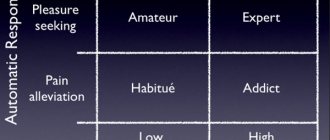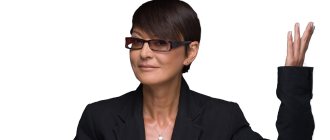Reasons for deviant behavior
Researchers such as E. S. Tatarinova, N. A. Melnikova, T. I. Akatova, N. V. Vorobyova, O. Yu. Kraev and others studied the causes of deviant behavior. Summarizing the authors’ research, we can identify the following reasons for the formation of deviant behavior.
- Errors in family education that destroy family education styles.
- Negative influence of spontaneous group communication (“bad company”).
- Abnormal personality development, crisis and difficult life situations.
- Accentuations of character (you can read more about this in the articles “Accentuations of character in psychology: norms or pathology”, “Accentuations of character in adolescence”).
- Psychosomatic disorders.
- Anomalies of psychophysical development.
- Lifestyle and risk factors (external circumstances).
Among the negative factors, two groups can be generally distinguished: public and private factors. The first includes the political, economic, social state of the country, and the general level of morality. Private factors mean personal motives, beliefs, goals. It is noted that personal factors are the basis of deviant behavior, and external factors are the guiding element, that is, they dictate the variant of deviation.
If we consider deviant behavior from the perspective of clinical psychology, we can distinguish two groups of factors: biological and social.
- The first include age-related crises, as well as congenital and acquired brain lesions.
- The second group includes the specifics of the environment, training and upbringing. Moreover, a stable connection between these factors has been noted, but it has not yet been determined exactly how they are interconnected.
Types of behavior
From the point of view of compliance with the rules and values of society, social and antisocial human behavior are distinguished.
Social behavior is a set of human behavioral processes associated with the satisfaction of physical and social needs and arising as a reaction to the surrounding social environment.
Antisocial behavior is actions that do not correspond to the norms and rules of behavior of people in society and public morality.
All-Russian negative factors
After analyzing a number of scientific works and reports, I was able to identify several leading all-Russian factors contributing to the development of deviant behavior as a mass social phenomenon. So, the negative factors include:
- growing commerce;
- cultivating physical strength and success;
- abundance of advertising;
- availability of digital materials, alcohol, cigarettes and drugs;
- uncertainty in life guidelines;
- the ever-evolving entertainment industry;
- shortcomings in the system for preventing deviations;
- sickness of the population (increase in socially dangerous diseases);
- information progress in Russia, transition to virtual technologies.
The media play a major role in the formation and development of deviant behavior. They promote various forms of deviations and antisocial behavior, affecting mainly the unformed consciousness (children, adolescents). Accordingly, thereby forming a personality with behavior that goes beyond accepted norms.
A striking example of the impact on consciousness is the Internet, or in a narrower sense, computer games. Often the virtual world is transferred to reality, which causes maladaptation of the individual.
Another option for the negative impact of the Internet is the desire to “hype” (gain popularity). And here we find echoes of Merton’s theory (I’ll describe it below). People strive to achieve their goal (popularity) in any way. And, unfortunately, as practice shows, it is easier to do this by killing someone (or beating them) and posting the video online, having sex in a public place, and so on. In pursuit of fame and “likes,” people forget about all standards of decency.
Types and forms of deviant behavior
To date, there is no single classification of deviant behavior. There are several different interpretations for one feature or another. The choice of reference classification depends on the sphere within which deviant behavior is analyzed and its main characteristics.
Classification by N.V. Baranovsky
The author identified socially positive and socially negative deviant behavior.
- The first ensures the progress of the entire society. We are talking about explorers, artists, generals, rulers. It is these people who doubt the established order of things, see the world differently and try to change it. That is, this is a productive type of deviant behavior.
- Socially negative deviant behavior is destructive in nature and ensures regression of the entire society. We are talking about criminals, addicts, terrorists.
This is the main primary classification. She explains what I talked about in the article “Theories of Deviant Behavior.” Everything is clear with productive: its type is the only possible one. While deviations in behavior with a minus sign have multiple guises. The classifications presented below interpret destructive behavior.
Classification by V. D. Mendelevich (domestic psychiatrist, narcologist, clinical psychologist)
I want to consider this author’s classification in more detail and consider it a reference point in my work. The author identifies the following types of deviant behavior:
- crime;
- alcoholism;
- addiction;
- suicidal behavior;
- vandalism;
- prostitution;
- sexual deviations.
In addition, V.D. Mendelevich notes that the type of behavior (deviant or normal) is determined by how the individual interacts with the world around him. He identifies five main styles of human interaction with society, that is, five styles of behavior, four of which are types of deviant behavior:
- Delinquent (criminal) behavior. This behavior arises when the individual is convinced that reality must be actively fought, that is, counteracted.
- Psychopathological and pathocharacterological type of deviant behavior. It manifests itself in a painful confrontation with reality. This is due to changes in the psyche, in which a person sees the world exclusively as hostile to him.
- Addictive behavior. Characterized by withdrawal from reality (use of psychoactive substances, passion for computer games, etc.). With this type of interaction, a person does not want to adapt to the world, believing that it is impossible to accept its realities.
- Ignoring reality. This is usually typical for a person engaged in some narrow professional focus. He seems to be adapted to the world, but at the same time he ignores anything other than his craft. This is the most common type of behavior, the most acceptable by society. This is normal behavior. The individual adapts to reality. It is important for him to find and realize himself in real life, among real people.
It has been experimentally proven that there is a relationship between all types of deviant behavior, as well as the dependence of deviations on the relationship of the individual with society.
There are other classifications, but I want to introduce you to them briefly. If something interests you, you can find additional material by authorship.
R. Merton's classification
The sociologist identified five types of deviations:
- subordination;
- innovation (achieving a goal by any means, even criminal);
- ritualism (observance of rules by self-infringement);
- retreatism (withdrawal from reality);
- rebellion (rebellion, revolutions, antisocial behavior).
That is, the classification is based on the relationship between the individual’s goal and the means to achieve it.
Classification by A. I. Dolgova
Divides deviations into two groups:
- deviant behavior;
- crime.
This division is often used when interpreting the behavior of children and adolescents. That is, a line is drawn between disobedience and serious offenses.
Classification by O. V. Polikashina
Identifies the following forms of deviations:
- committing offenses;
- drunkenness;
- addiction;
- substance abuse;
- use of psychotropic substances;
- early sexual promiscuity.
Generally accepted classification in clinical psychology
Clinical psychology has its own concepts and types of deviant behavior. According to the DSM IV classification, in conduct disorder (as deviant behavior is called in the medical field of psychology), four types of behavior problems can occur:
- aggression towards others;
- destruction of property;
- theft;
- other serious violations of the rules.
The International Classification of Diseases, 10th revision (ICD-10) identifies several types of behavioral disorders (hereinafter referred to as BD):
- PD limited to the family (antisocial or aggressive behavior manifested at home or towards close people);
- unsocialized RP (dissocial or aggressive behavior towards other children);
- socialized RP (dissocial or aggressive behavior in children who are well integrated into the peer group);
- oppositional defiant disorder (outbursts of anger, bickering, defiant behavior).
I will try to explain the meaning of multiple classifications and the possibilities of their application. For example, if it is established that the cause of deviations lies in pathological changes in the brain, then you need to focus on ICD-10 and DSM IV. If behavior was influenced by a social (psychological) factor rather than a biological one, then it is better to pay attention to the classification of V. D. Mendelevich.
Types of personality behavior
1
According to the concept of the American psychologist McGuire, the classification of human behavior and actions should be carried out depending on goals, needs, and situations. Need is an experienced and perceived state of a person’s need for something (food, clothing, safety, love, etc.). The goal shows what a person is striving for, what result he wants to get. The same goal can be set based on different needs.
1. Perceptual behavior - the desire to cope with information overload through perceptual categorization, as a result of which the variety of influencing information is classified, simplified and can lead to both a clearer understanding of what is being assessed and the loss of significant information.
2. Defensive behavior - any real or imaginary actions of psychological defense (rejection, substitution, projection, regression) that allow you to create and maintain a positive image of “I”, a person’s positive opinion about himself.
3. Inductive behavior – people’s perception and assessment of themselves based on the interpretation of the meaning of their own actions.
4. Habitual behavior - satisfaction from positive reinforcement - creates a greater likelihood of reproducing familiar behaviors in appropriate situations.
5. Utilitarian behavior is a person’s desire to solve a practical problem with maximum achievement (subjective experience of the maximum possible success).
6. Role behavior in accordance with role requirements, circumstances that force a person to take some actions (even if they do not coincide with personal aspirations).
7. Scripted behavior - a person is an executor of many rules of acceptable “decent” behavior corresponding to his status in a given culture and society.
8. Modeling behavior - behavior options of people in small and large groups (infection, imitation, suggestion), but difficult to control both by the person himself and by other people.
9. Balancing behavior - when a person simultaneously has contradictory opinions, assessments, and attitudes and tries to “reconcile” them, coordinate them by changing his assessments, claims, and memories.
10. Liberating behavior - a person seeks to “protect himself” (physically or his reputation) from real or apparent “negative conditions of existence” (maintain the stability of his internal emotional state through active external actions: avoiding possible failures, abandoning environments of unattractive goals, compliance .
11. Attributive behavior - active elimination of contradictions between real behavior and a subjective system of opinions, weakening, eliminating cognitive dissonance between desires, thoughts and real actions, bringing them to mutual correspondence.
12. Expressive behavior - in those cases, areas in which a person has achieved a high level of mastery and satisfaction from a “job well done,” while maintaining consistently high self-esteem, the constant reproduction of which is the main regulator of everyday social behavior.
13. Autonomous behavior - when a sense of freedom of choice (even the illusion of such choice and control of one’s actions) creates a person’s willingness to overcome any barriers to achieving a goal (a high level of internal “locus of control” of one’s actions, the idea of oneself as an active “doer”, and not an executor of someone’s orders, someone’s will).
14. Affirmative behavior - experiencing your actions as the accomplishment of your plans with maximum use of your own internal conditions.
15. Exploratory behavior - the desire for novelty in the physical and social environment, the willingness to “tolerate” information uncertainty, the “reduction” of various external information to a form to which previously mastered processing techniques are applicable.
16. Empathic behavior - taking into account, a large coverage of sensory information underlying interpersonal interaction between people, the ability to feel and understand the emotional and mental state of another person.
Needs
Need - implies the absence or shortage of something necessary for balance.
Desire is associated with a feeling of need or biological
(eat, sleep) or
intellectual
(read).
The classification of motives according to A. Maslow is as follows:
| Physiological needs: | hunger, thirst, sexuality, etc. - to the extent that they have a homeostatic and organismic nature; |
| Security Needs: | safety and protection from pain, fear, anger, disorder; |
| Social connection needs: | needs for love, tenderness, social connection, identification; |
| Self-esteem needs: | needs for recognition, approval; |
| Self-actualization needs: | realization of one's own capabilities and abilities; the need for understanding and comprehension. |
Self-actualization can become a motive for behavior only when all other needs are satisfied. In case of conflict between the needs of different hierarchical levels, the lower need wins.
A. Maslow called the needs of the lower levels scarce , and the needs of the higher levels – growth needs .
A. Maslow pointed out that there are differences between lower and higher needs. Here are some of them:
1.Higher needs are genetically later.
2.The higher the level of need, the less important it is for survival, the further its satisfaction can be postponed and the easier it is to free yourself from it for a while.
3.Living at a higher level of needs means higher biological efficiency, longer duration, good sleep, appetite, less illness, etc.
4.Higher needs are subjectively perceived as less urgent.
5. Satisfaction of higher needs more often results in the fulfillment of desires and personal development, more often brings happiness, joy and enriches the inner world.
Motivation
Motivation is a set of factors that determine behavior and describes the relationship that exists between an action and the reasons that explain or justify it.
Motives of behavior can be both unconscious (instincts and drives) and conscious (aspirations, desires, desires). In addition, the implementation of a particular motive is closely related to volitional effort (voluntariness - involuntariness) and control over behavior.
Instinct is a set of innate human actions, which are complex unconditioned reflexes necessary for adaptation and performance of vital functions (food, sexual and protective instincts, self-preservation instinct, etc.).
Attraction is most common in very young children. Attraction is most closely connected with elementary feelings of pleasure and displeasure. Any feeling of pleasure is associated with a natural desire to maintain and continue this state. This is especially noticeable when, for one reason or another, sensory pleasure is interrupted. In these cases, the child begins to show a state of greater or lesser anxiety. On the other hand, every unpleasant feeling is accompanied by a natural desire to get rid of its source. Since the characteristic feature of the drive, despite all its unconsciousness, is its active nature, it should be considered as the starting point in the development of the will. Drives in their pure form are characteristic of infancy, when needs are strong, but consciousness is still weak and undeveloped.
Pursuit. As the child’s consciousness develops, his drives begin to be accompanied, at first by a still vague, and then by an increasingly clear consciousness of the need he is experiencing. This occurs in cases where the unconscious desire to satisfy an emerging need encounters an obstacle and cannot be realized. In such cases, the unsatisfied need begins to be realized in the form of a still vague desire for a more or less specific object or object with the help of which this need can be satisfied.
Wish. Its characteristic feature is a clear and definite representation of the goal to which a person strives. Desire always refers to the future, to what is not yet in the present, what has not yet come, but what we would like to have or what we would like to do. At the same time, there are still no or very vague ideas about the means by which a clearly defined goal can be achieved.
Wants are a higher stage in the development of motives for action, when the idea of a goal is joined by the idea of the means by which this goal can be achieved. This allows you to draw up a more or less firm plan to achieve your goal. Compared to a simple desire, a desire has a more active, businesslike nature: it expresses the intention to carry out an action, the desire to achieve a goal using certain means. The very idea of the goal becomes more definite and concrete, more real, which is greatly facilitated by the knowledge expressed in the desire of specific means and ways to achieve the goal.
.
Types of motives:
· The motive of self-affirmation is the desire to establish oneself in society; associated with self-esteem. A person tries to prove to others that he is worth something, strives to obtain a certain status in society, wants to be respected and appreciated.
· The motive for identification with another person is the desire to be like a hero, an idol. This motive encourages you to work and develop. It is especially relevant for teenagers who try to copy the behavior of other people.
· The power motive is the individual’s desire to influence people. The motivation of power is one of the most important driving forces of human action. This is the desire to take a leadership position in a group, an attempt to lead people, determine and regulate their activities.
· Procedural-substantive motives - an incentive to activity by the process and content of the activity, and not by external factors. A person likes to perform this activity, to demonstrate his intellectual or physical activity. He is interested in the content of what he is doing.
· The motive of self-development is the desire for self-development, self-improvement. This is an important motive that encourages an individual to work hard and develop. This is the desire to fully realize one’s abilities and the desire to feel competent.
· Achievement motive - the desire to achieve high results and mastery in activities; it manifests itself in the choice of difficult tasks and the desire to complete them. Success in any activity depends not only on abilities, skills, knowledge, but also on motivation to achieve.
1
Date added: 2016-07-18; views: 11888; ORDER A WORK WRITING
Similar articles:
Types and forms of deviant behavior in children and adolescents
I would like to include in a separate category children’s and adolescent deviations, which are primarily due to the specifics of the ages themselves. Among the common deviations, the following forms can be distinguished:
- risky sexual behavior;
- self-destructive behavior;
- vagrancy;
- new forms of deviant behavior (involvement in totalitarian destructive sects and other public organizations that manipulate consciousness, terrorism, deviations using the Internet and computer).
According to the direction of deviation, they can be divided into:
- deviations of selfish orientation;
- aggressive deviations directed against the individual (self-destruction);
- socially passive deviations (various kinds of departure from reality).
Within the framework of self-destructive behavior, several more forms can be distinguished:
- hidden and direct suicide;
- disorders of habits and desires;
- eating disorders;
- substance use disorders;
- Personality behavioral disorders in the sexual sphere.
Thus, in adolescence and childhood, deviant behavior is more often manifested by aggression, evasion from school, running away from home, drug addiction and drunkenness, suicidal attempts, and antisocial behavior.
- The most popular deviation of adolescence is dependent behavior.
- It is not uncommon for a person who has not yet formed a desire to escape from reality, from problems and misunderstandings. Perhaps this is the easiest way.
- In addition, addictions can be formed based on the teenager’s desire for adulthood. And the simplest form of adulthood is external copying.
- Another common cause of addiction is the teenager’s desire to establish himself among his peers, gain authority and trust. After all, peers at this age are the main “judges” and “audience”.
Girls in adolescence are more likely to develop sexual deviations. Active puberty is directly related to the development of secondary sexual characteristics, which can lead to ridicule from peers or unwanted sexual advances. In addition, girls often begin relationships with older young men, which promotes sexual activity and various risky and antisocial behaviors.
It is worth noting that deviant behavior of adolescents is not always negative. Sometimes teenagers want to find something new, to overcome stagnation and conservatism. On this basis arise:
- music bands;
- theater companies;
- athletes;
- young artists.
You can read more about the characteristics of deviant behavior in children and adolescents in my work “Deviant Behavior in Children and Adolescents: Causes, Prevention and Correction.”











